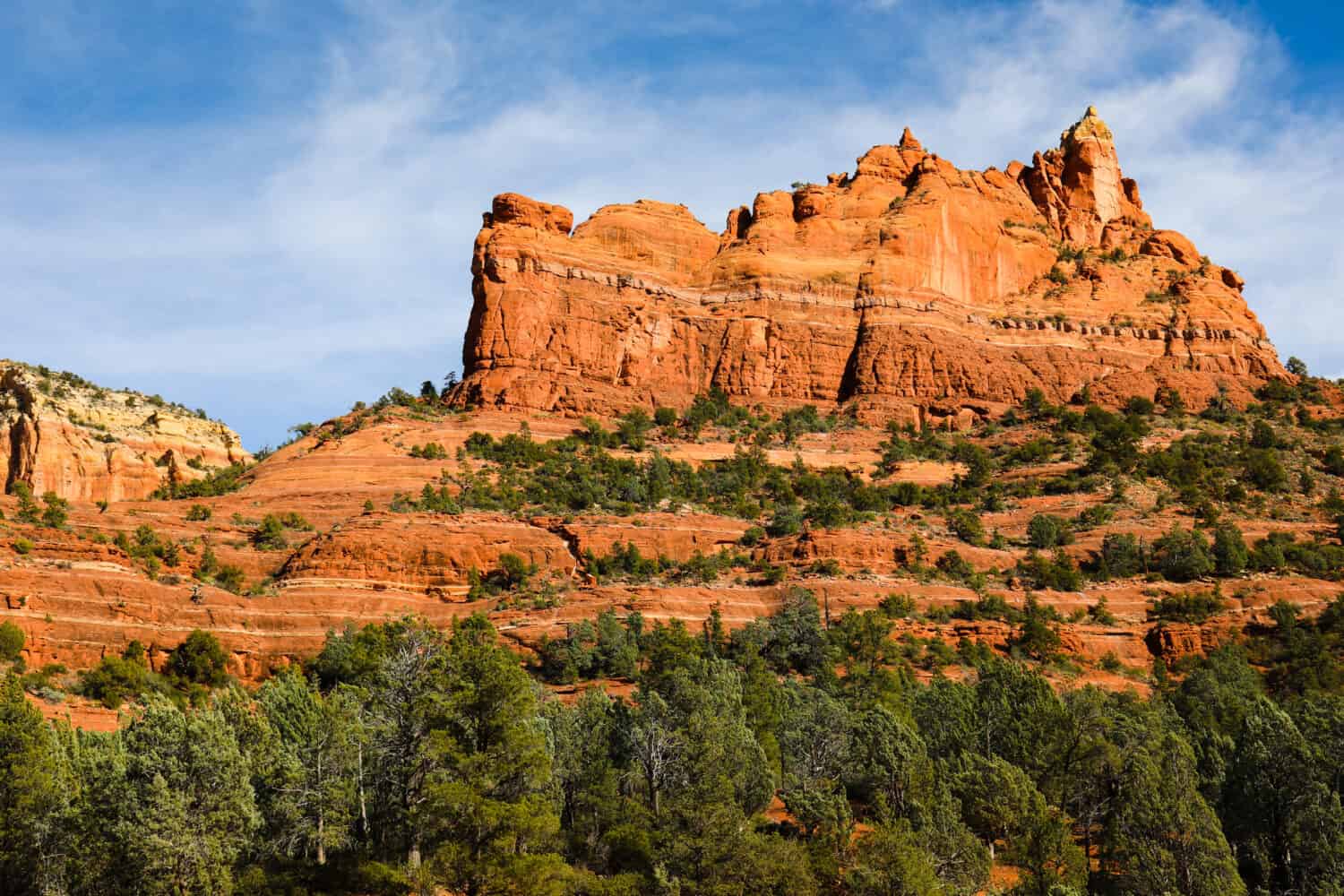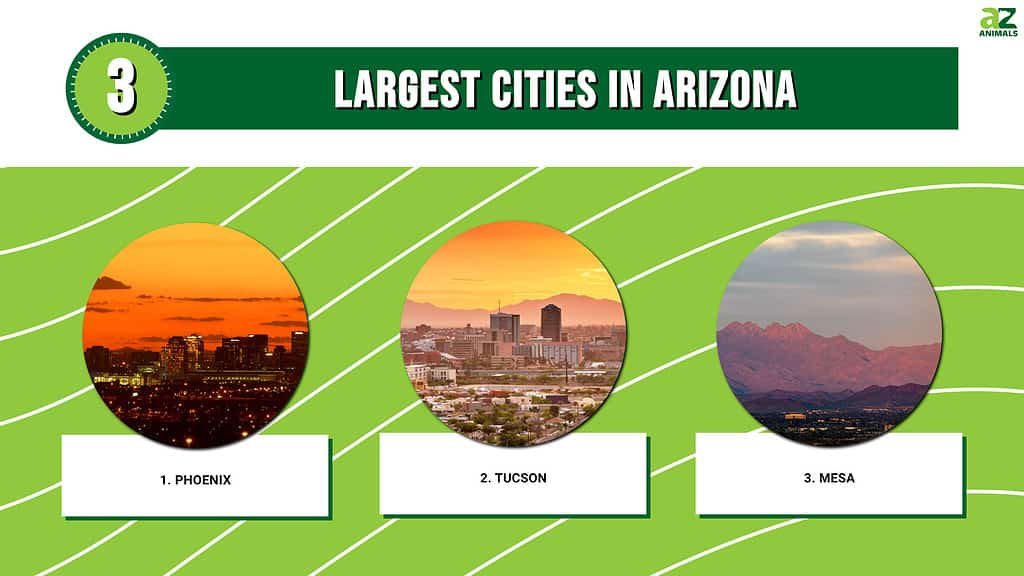
Introduction
While some of the largest cities in Arizona may seem familiar, others are not as well-known to the general population. In addition, the largest cities listed may be chosen by population, total area, Gross Domestic Product, or median household income. However, one city trumps all others in three categories, making it the largest city in the state and one of the largest cities in the country. Find out which Arizona cities are the largest and discover facts about each.

Learn about the Arizona city that is largest by population, GDP, and total area.
©Amine Abassir, CC BY-SA 4.0, via Wikimedia Commons – Original / License
Largest Arizona Cities by Population and Economic Impact
Phoenix
Phoenix ranks as the largest city in the state of Arizona by population, total area, and economic impact. The population of Phoenix measures 1,651,344 with an annual population growth rate of 0.82%. In addition, Phoenix holds the title of the fifth-largest city in the United States, following Houston, Chicago, Los Angeles, and New York City. Furthermore, the metropolitan area population of Phoenix numbers 4.949 million residents.
Phoenix covers 517.67 square miles, making it the largest city in Arizona by area, too. The square mileage of Phoenix translates to 1,340.76 square kilometers and over 330,000 acres. Finally, the city has a Gross Domestic Product (GDP) of 261.71 billion U.S. dollars, as of 2021. The GDP of Phoenix makes up over three-fourths of the state of Arizona’s entire GDP.
In addition, the GDP per capita in Phoenix measures $44,534, as of 2017. The GDP per capita typically describes the standard of living in a certain area. However, GDP per capita may fluctuate greatly according to changes in population. Thus, a city with a high GDP per capita does not always signify wealth. Wealth in a specific area usually derives from the median household income. The median household income in Phoenix lies around $60,914, as of 2020.
While farming and ranching once supported the economy of Phoenix, the city’s main industries now include technology, certain services, and tourism. In addition, manufacturing makes up a large part of the Phoenix economy and provides many jobs to the city’s residents. Some goods manufactured in Phoenix include cosmetics, electronics, and aerospace technology. While agriculture does not dominate the economy of the city, it still supports it significantly. Crops important to the Phoenix area are fruits, vegetables, and cotton. Finally, the largest employers in Phoenix include finance and banking, but tourism and hospitality also employ many residents, specifically during the winter months.
Phoenix Facts
- The area in which Phoenix lies receives around 320 days of sun every year. Phoenix is the sunniest major city in America.
- Phoenix features professional sports teams in the NBA, NFL, NHL, and MLB. Few major cities claim teams in all four major sports categories.
- This city is the only state capitol that boasts more than one million residents.
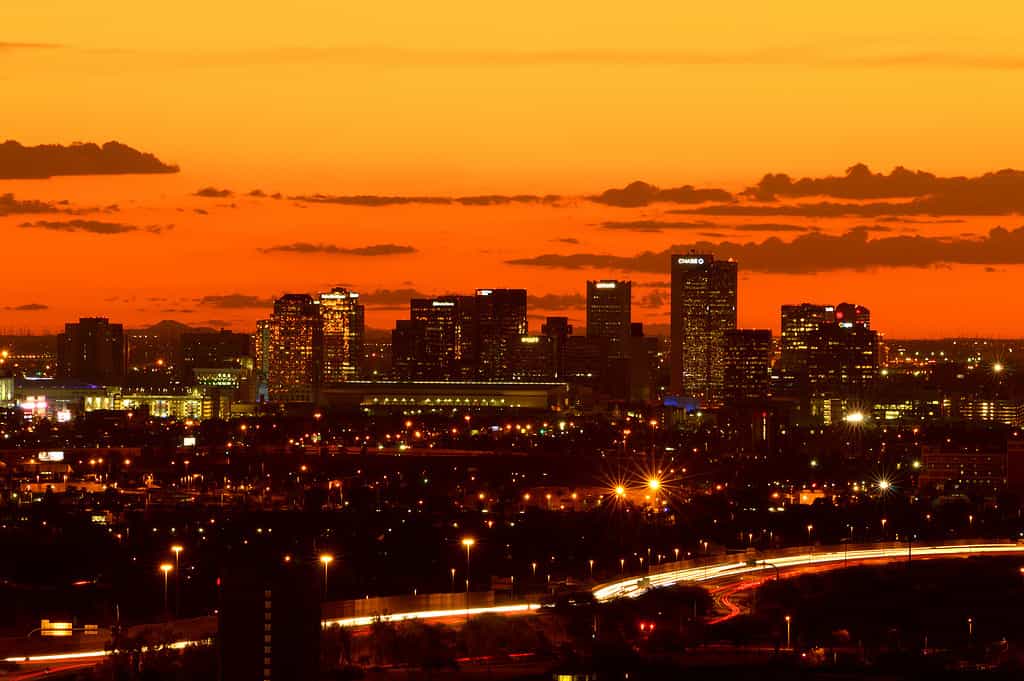
Phoenix, Arizona is the
capital of the state
and has a population of 1.651 million.
©iStock.com/gillcouto
Tucson
Tucson is the second-most populous city in Arizona with a population of 546,019. In addition, Tucson’s annual rate of population growth measures 0.26%. The total area of Tucson measures 238.01 square miles–or 616.44 square kilometers. The square mileage of Tucson translates to over 150,000 acres. Furthermore, the median household income of this city sits at $48,050, as of 2021, and Tucson has a GDP per capita of $33,088. Tucson’s total GDP amounts to around $50.23 billion, as of 2021.
The main industries in Tucson include tourism, hospitality, and manufacturing. Manufacturing in Tucson focuses on goods like electronics, aircraft, and missiles. In addition, many people choose to retire in Tucson, as the weather and wildlife in this city remain extremely attractive. Furthermore, many resorts support Tucson’s economy. Retirement communities and resorts provide numerous jobs in the area alongside manufacturing work. Finally, Tucson’s economy and industries have contributed to its gradual population growth since the end of World War II.
Tucson Facts
- Tucson features more bird species than any other location on Earth, excluding the Amazon Rainforest.
- Supposedly, pop star Justin Bieber owns land near the city of Tucson.
- The cost of living in Tucson measures 8.5% lower than the national average.
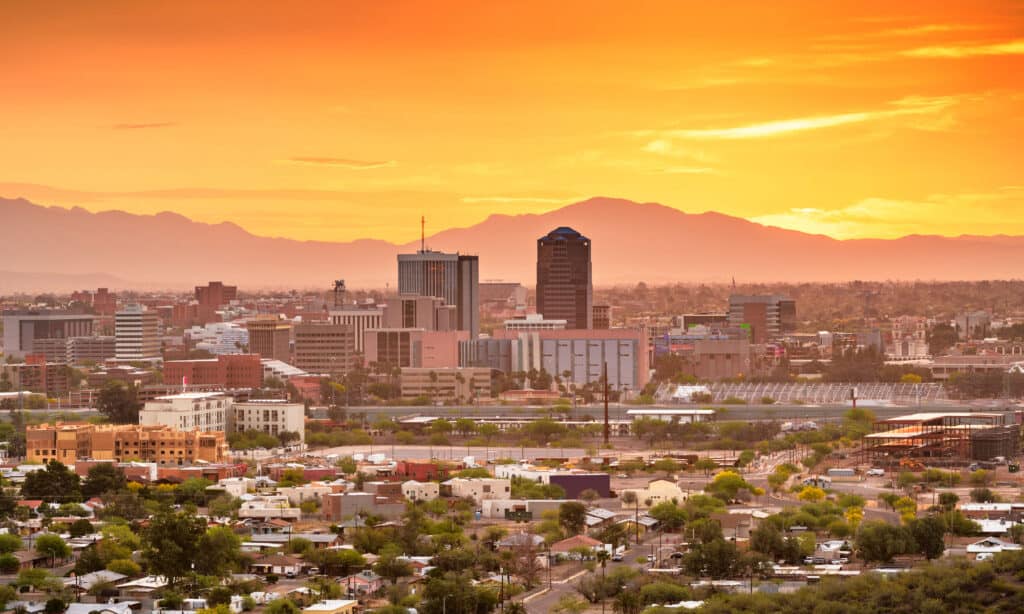
Tucson boasts more bird species than any other city in the country.
©iStock.com/Credit:Sean Pavone
Mesa
The city of Mesa holds the title of Arizona’s third-most populous city with a population numbering 516,783 residents. Furthermore, the annual population growth rate of Mesa measures 0.71%. Mesa covers around 138.09 square miles, translating to 357.65 square kilometers and around 88,000 acres. In addition, the median household income of Mesa lies at approximately $65,725. One interesting fact about Mesa is that it belongs to the Phoenix metropolitan area as an eastern suburb. As a suburb of Phoenix, Mesa’s recorded GDP aligns with that of Phoenix at 261.71 billion U.S. dollars, as of 2021.
Furthermore, Mesa has seen incredible job opportunities open up in recent years. Over the next decade, Mesa is expected to experience a 47.1% increase in job availability and growth. Technology–specifically medical technology–development and research have grown significantly in the Mesa area. In addition, Mesa’s main industries include education, healthcare, aerospace research and manufacturing, and tourism. As a part of the Phoenix metropolitan area, Mesa shares many of the same industries and job markets as Phoenix.
Mesa Facts
- Mesa is the largest suburban city in the nation with an impressive population of over half a million residents.
- The city was established in 1878 by members of the Church of Jesus Christ of Latter-Day Saints.
- The Major League Baseball team the Chicago Cubs train in Mesa every spring.
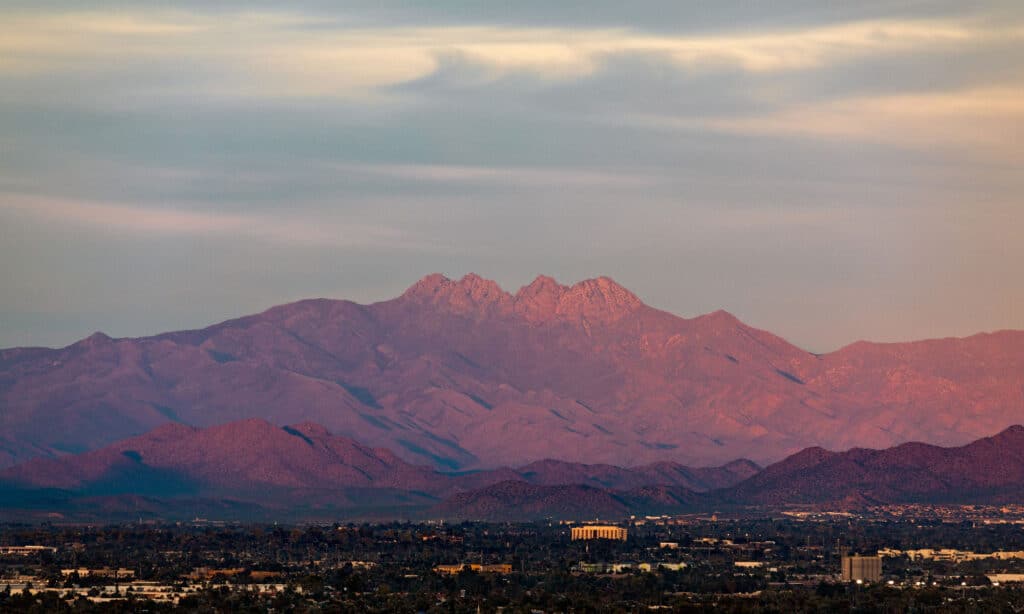
Mesa, Arizona is a suburb of Phoenix and one of the largest suburban cities in America.
©iStock.com/mdesigner125
The Largest Cities in Arizona by Population: A Summary
| City | Population | Population Density (per square mile) | Annual Growth Rate |
|---|---|---|---|
| Phoenix | 1.651 million | 3,104.5 | 0.82% |
| Tucson | 546,019 | 2,251.6 | 0.26% |
| Mesa | 516,783 | 3,635.5 | 0.71% |
The Largest Cities in Arizona by GDP: A Summary
| City | Gross Domestic Product (GDP) |
|---|---|
| Phoenix | 261.71 billion U.S. dollars |
| Tucson | 50.23 billion U.S. dollars |
| Mesa (Phoenix suburb) | 261.71 billion U.S. dollars |
Largest Arizona Cities by Total Area
Buckeye
Buckeye, Arizona is the second-largest city in Arizona by total area, covering around 375.26 square miles. In addition, the square mileage of Buckeye translates to approximately 971.92 square kilometers and over 240,000 acres. Furthermore, the population of Buckeye lies around 119,434 residents. The annual population growth rate of Buckeye sits at an impressive 8.57%, which is greater than nearly every other city in the state. The median household income of the city measures $84,568.
Buckeye Facts
- The coldest temperature ever recorded in this city measures only 11ºF.
- Buckeye is also a suburb of the Phoenix metropolitan area, located about 30 miles west of Phoenix.
- Visitors of Buckeye can visit Skyline Regional Park, which features hiking trails, campsites, and horseback riding.

Skyline Regional Park in Buckeye, Arizona includes many outdoor activities for visitors to enjoy.
©algesoft/Shutterstock.com
Valle
Valle, Arizona ranks #3 on the list of largest cities by total area in the state. The area of Valle covers 243.89 square miles, making it slightly larger in area than the city of Tucson. Valle also covers around 631.67 square kilometers and over 155,000 acres. While the other largest cities in Arizona by total area boast moderate to large populations, Valle is a tiny town with a population of only 101 residents. Valle is so small that little data is available concerning its median household income. However, some estimates show an average household income in the city measuring $57,956. In addition, the annual population growth rate of Valle measures an astounding -61.54%.
Valle Facts
- Valle was not recognized as a town by the United States Geological Survey until the year 1980.
- Many people refer to the Valle area as the “Grand Canyon Junction.”
- The population of Valle has decreased significantly. While Valle’s population stands at 101 residents today, it measured 832 residents, as of 2010.
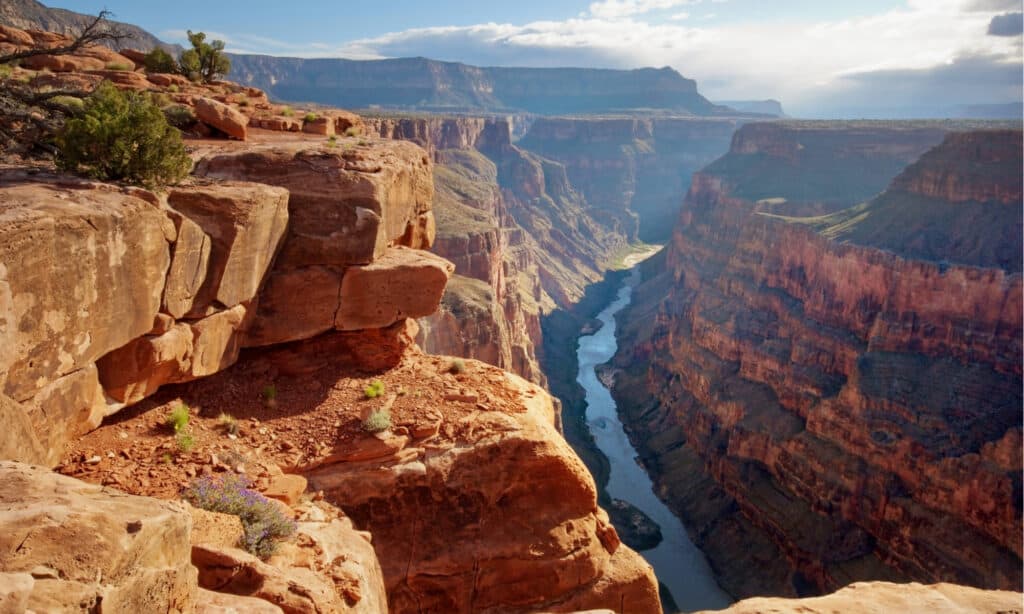
Valle, Arizona lies just south of the Grand Canyon.
©sumikophoto/Shutterstock.com
The Largest Cities in Arizona by Total Area: A Summary
| City | Area (mi2) | Area (km2) | Acreage |
|---|---|---|---|
| Phoenix | 517.67 | 1,340.76 | 331,309 |
| Buckeye | 375.26 | 971.92 | 240,166 |
| Valle | 243.89 | 631.67 | 156,090 |
Largest Arizona Cities by Median Household Income
Paradise Valley
Not only is Paradise Valley, Arizona one of the wealthiest cities in the state, but it is also one of the wealthiest cities in the nation. The median household income of Paradise Valley measures an incredible $211,393. The town is small, though, boasting around 12,644 residents. In addition, the annual population growth rate of the city sits at -0.15%. The total area of Paradise Valley also remains small, measuring around 15.43 square miles–or 39.96 square kilometers. The acreage of this town sits at just over 9,800 acres.
Paradise Valley Facts
- Some celebrities that own or have owned homes in Paradise Valley include Michael Phelps, Alice Cooper, and Muhammad Ali.
- Paradise Valley features nine resorts for visitors and celebrities to enjoy.
- The main industries and top employers in Paradise Valley include hospitality and tourism.
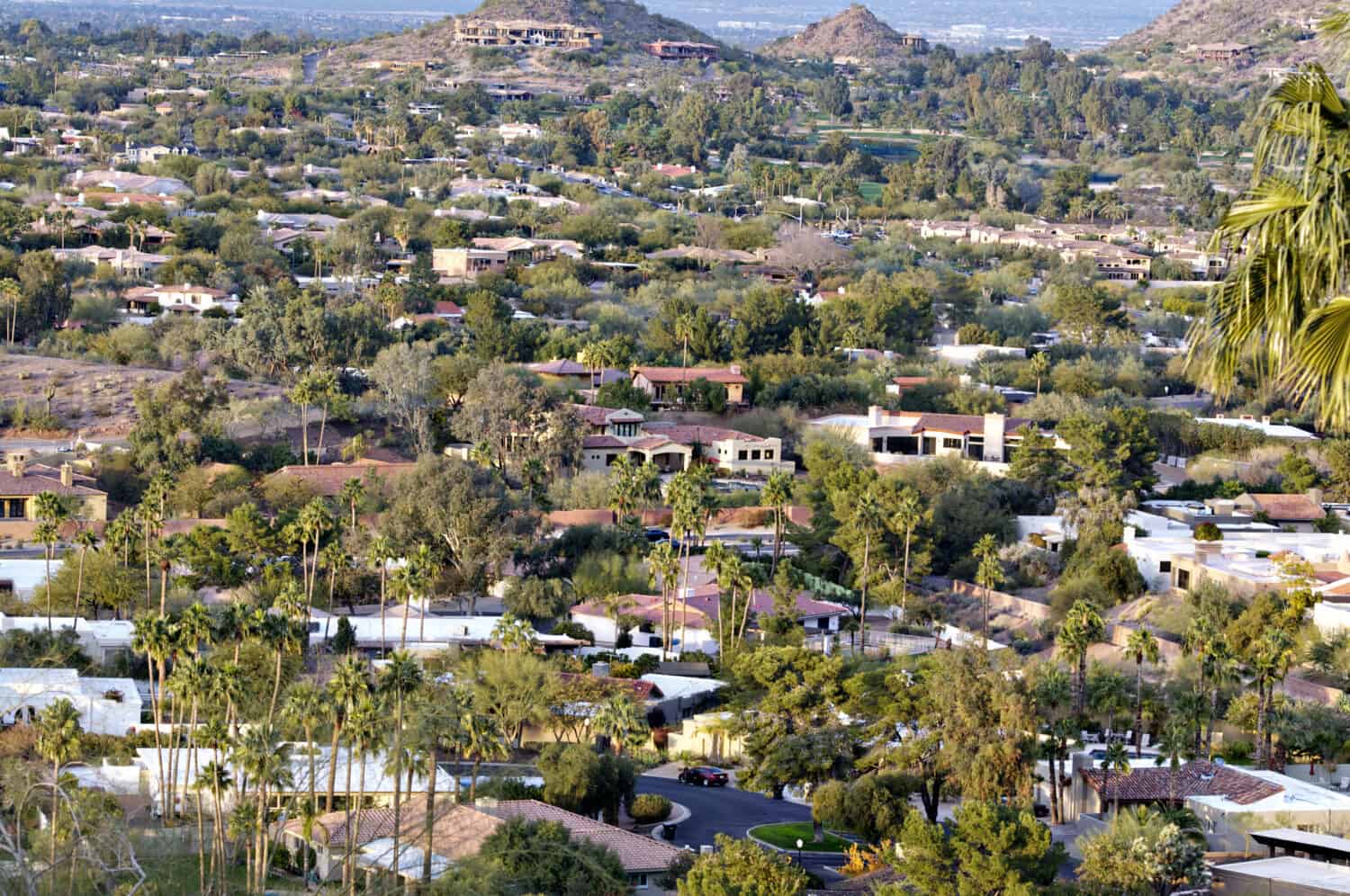
Paradise Valley is the wealthiest city in Arizona by median household income, which measures $211,393.
©BCFC/Shutterstock.com
Queen Creek
The second-wealthiest city in Arizona is Queen Creek, which boasts a median household income of $105,729. The city covers around 40.32 square miles, as of 2020, which translates to 104.43 square kilometers. The acreage of Queen Creek measures slightly over 25,800 acres. In addition, Queen Creek claims a population of 59,519, as of 2020. However, some population estimates for 2022 cite a population in Queen Creek of 70,734 residents. Considering the city’s high annual population growth rate of 8.87%, which beats the growth rate of Buckeye, Arizona, it’s likely that the population in this city has grown well over 70,000 residents.
Queen Creek Facts
- Queen Creek primarily focused on agriculture until the 1990s and 2000s, when the town experienced incredible growth.
- Schools in Queen Creek rank far above the national averages for quality and academic standards.
- San Tan Mountain Regional Park lies near Queen Creek, and the park features unique wildlife and beautiful landscapes.
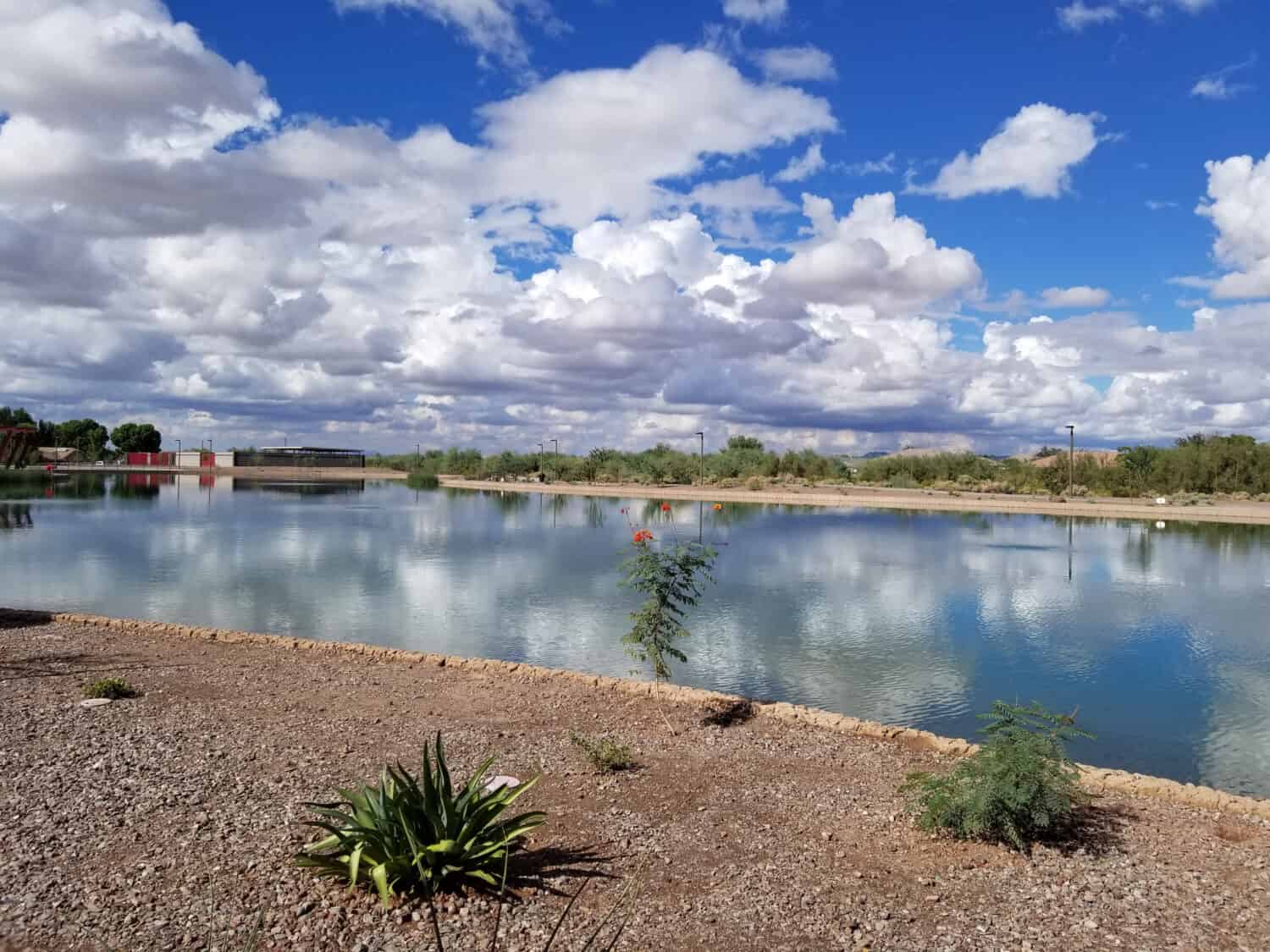
Queen Creek features Mansel Carter Oasis Park and is the second-wealthiest city in the state.
©Cheryl Silverstein/Shutterstock.com
Gilbert
Like the city of Mesa, Gilbert lies close to the Phoenix metropolitan area and ranks as the third-wealthiest city in Arizona. The median household income in Gilbert measures $96,857. Gilbert’s population for 2023 is estimated at 281,169 residents, making it significantly larger than Arizona’s top two wealthiest cities. In addition, Gilbert’s annual population growth rate sits at 1.46%. The total area of the city measures 68.57 square miles–or 177.60 square kilometers. In addition, the acreage of Gilbert measures nearly 44,000 acres.
Gilbert Facts
- The average temperature in this city during the month of January measures 67ºF.
- Jim Bechtel, who is known internationally for his poker-playing skills, is from Gilbert.
- Some activities in Gilbert include parades, rodeos, carnivals, and more.
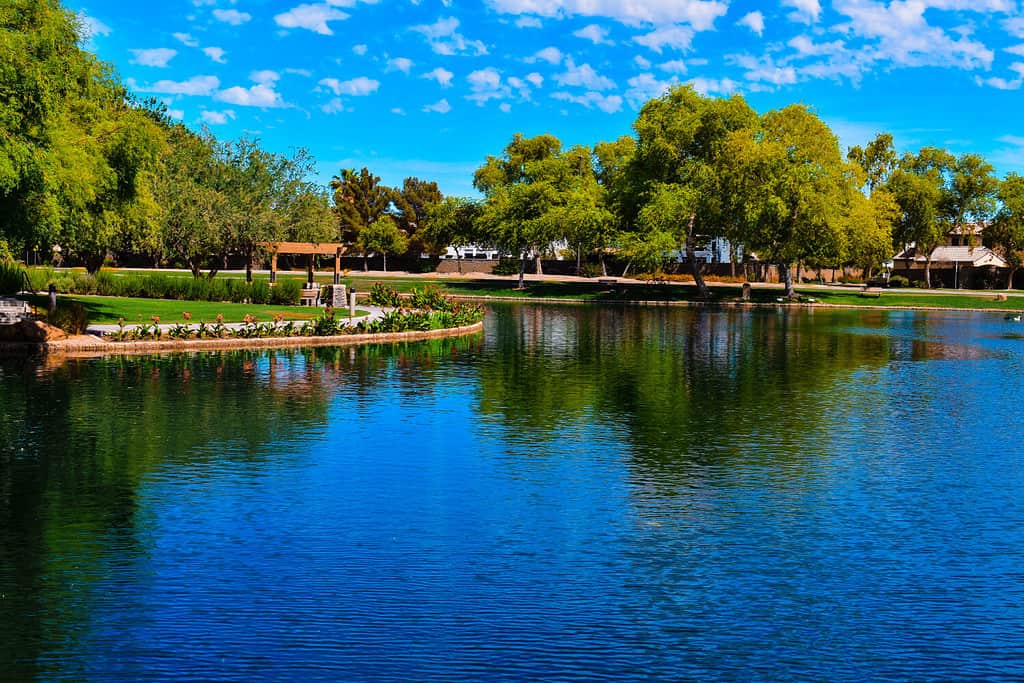
The median household income in Gilbert, Arizona is $96,857, and the population measures 281,169 residents.
©Eric Ravenscroft/Shutterstock.com
The Largest Cities in Arizona by Median Household Income: A Summary
| City | Median Household Income |
|---|---|
| Paradise Valley | $211,393 |
| Queen Creek | $105,729 |
| Gilbert | $96,857 |
Thank you for reading! Have some feedback for us? Contact the AZ Animals editorial team.

